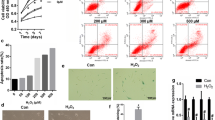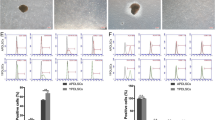Abstract
Background
Human periodontal ligament cells (hPDLCs) can be applied in periodontal regeneration engineering to repair the tissue defects related to periodontitis. Theoretically, it can affect the vitality of hPDLCs that cell aging increases apoptosis and decreases autophagy. Autophagy is a highly conserved degradation mechanism, which degrades the aging and damaged intracellular organelles through autophagy lysosomes to maintain normal intracellular homeostasis. Meanwhile, autophagy-related gene 7 (ATG7) is a key gene that regulates the level of cellular autophagy.
Objective
This study was to explore the effects of autophagic regulation of aging hPDLCs on cell proliferation and cell apoptosis.
Methods
A cell model of aging hPDLCs overexpressing and silencing ATG7 were respectively constructed by lentiviral vectors in vitro. A series of experiments was performed to confirm relevant senescence phenotype on aging hPDLCs, and to detect the effects of changes in autophagy on their proliferation and apoptosis-related factors in aging hPDLCs.
Results
The results showed that overexpression of ATG7 could motivate autophagy, promoting proliferation of aging hPDLCs and inhibiting apoptosis synchronously (P < 0.05). On the contrary, suppressing autophagy levels by silencing ATG7 would inhibit cell proliferation and accelerate cell senescence (P < 0.05).
Conclusion
ATG7 regulates the proliferation and apoptosis of aging hPDLCs. Hence, autophagy may act as a target to delay senescence of hPDLCs, which can be helpful in the future in-depth study on regeneration and functionalization of periodontal supporting tissues.





Similar content being viewed by others
References
LEE E, KIM Y S, LEE Y M et al (2021) Identification of stemness and differentially expressed genes in human cementum-derived cells [J]. J periodontal implant Sci 51(5):329–341
SUN G, YANG Y, LU X et al (2019) Comparison of Periodontal Ligament Cell lines with adenovirus- and lentivirus-mediated human telomerase reverse transcription expression [J]. Hum Gene Ther Methods 30(2):53–59
KONO K, MAEDA H, FUJII S et al (2013) Exposure to transforming growth factor-β1 after basic fibroblast growth factor promotes the fibroblastic differentiation of human periodontal ligament stem/progenitor cell lines [J]. Cell Tissue Res 352(2):249–263
WANG L, SHI S, BAI R et al (2020) Biological properties of bone marrow stem cells and adipose-derived stem cells derived from T2DM rats: a comparative study [J], vol 10. Cell & bioscience, p 102
MCHUGH D (2018) Senescence and aging: causes, consequences, and therapeutic avenues [J]. J Cell Biol 217(1):65–77
MUñOZ-ESPíN D, CAñAMERO M, MARAVER A et al (2013) Programmed cell senescence during mammalian embryonic development [J]. Cell 155(5):1104–1118
KUILMAN T, MICHALOGLOU C, MOOI W J et al (2010) The essence of senescence [J]. Genes Dev 24(22):2463–2479
SALMINEN A, KAARNIRANTA K (2013) Beclin 1 interactome controls the crosstalk between apoptosis, autophagy and inflammasome activation: impact on the aging process [J]. Ageing Res Rev 12(2):520–534
HANSEN M, RUBINSZTEIN D C (2018) WALKER D W. Autophagy as a promoter of longevity: insights from model organisms [J]. Nat Rev Mol Cell Biol 19(9):579–593
MIZUSHIMA N (2011) Autophagy: renovation of cells and tissues [J]. Cell 147(4):728–741
Cawthon H, Chakraborty R, Roberts JR et al (2018) Control of autophagosome size and number by Atg7[J].Biochem Biophys Res Commun. 2.651-656.
CHOI S I DADAKHUJAEVS, MAENG Y S et al (2015) Disrupted cell cycle arrest and reduced proliferation in corneal fibroblasts from GCD2 patients: a potential role for altered autophagy flux [J]. Biochem Biophys Res Commun 456(1):288–293
DAI J, SUN Y, CHEN D et al (2019) Negative regulation of PI3K/AKT/mTOR axis regulates fibroblast proliferation, apoptosis and autophagy play a vital role in triptolide-induced epidural fibrosis reduction [J]. Eur J Pharmacol 864:172724
QIN R, CUI Z, ZHOU H et al (2022) Effect of lentivirus-mediated BMP2 from autologous tooth on the proliferative and osteogenic capacity of human periodontal ligament cells [J]. J Periodontal Res. https://doi.org/10.1111/jre.13025
CAO Y, YANG W TYLERMA et al (2013) Noggin attenuates cerulein-induced acute pancreatitis and impaired autophagy [J]. Pancreas 42(2):301–307
CAI B, ZHENG Y (2019) BMP2-mediated PTEN enhancement promotes differentiation of hair follicle stem cells by inducing autophagy [J]. Exp Cell Res 385(2):111647
KWON T, LAMSTER I B LEVINL (2021) Current concepts in the management of periodontitis [J]. Int Dent J 71(6):462–476
TOMOKIYO A, WADA N (2019) Periodontal Ligament Stem cells: regenerative potency in periodontium [J]. Stem Cells Dev 28(15):974–985
MITSIADIS TA (2009) Cell fate determination during tooth development and regeneration [J]. Birth defects research part C, embryo today: reviews. 87(3):199–211
KONG Y, CUI H (2011) Regulation of senescence in cancer and aging [J]. J Aging Res 2011:963172
HE C, ZHOU C, KENNEDY B K (2018) The yeast replicative aging model [J]. Biochim Biophys Acta Mol Basis Dis 1864(9 Pt A):2690–2696
UCHIL PD, NAGARAJAN A (2017) KUMAR P. β-Galactosidase [J]. Cold Spring Harbor protocols, 2017(10): pdb.top096198
KARIMIAN A, AHMADI Y (2016) Multiple functions of p21 in cell cycle, apoptosis and transcriptional regulation after DNA damage [J]. DNA Repair 42:63–71
DING Q, LIU H, LIU L et al (2021) Deletion of p16 accelerates fracture healing in geriatric mice [J]. Am J translational Res 13(10):11107–11125
LIPINSKI M M, ZHENG B, LU T et al (2010) Genome-wide analysis reveals mechanisms modulating autophagy in normal brain aging and in Alzheimer’s disease [J]. Proc Natl Acad Sci USA 107(32):14164–14169
YANG M C, LIN R W, HUANG S, B et al (2016) Bim directly antagonizes bcl-xl in doxorubicin-induced prostate cancer cell apoptosis independently of p53 [J]. 15(3):394–402 Cell cycle (Georgetown, Tex)
CHILDS B G, BAKER D J, KIRKLAND JL et al (2014) Senescence and apoptosis: dueling or complementary cell fates? [J]. EMBO Rep 15(11):1139–1153
ARGUELLES S, GUERRERO-CASTILLA A, CANO M et al (2019) Advantages and disadvantages of apoptosis in the aging process [J]. Ann N Y Acad Sci 1443(1):20–33
ZENG S, QIN X, HE X et al (2016) [Construction of human mucosa oral epithelial cell lines overexpressing telomerase reverse transcriptase gene mediated by lentivirus] [J]. Hua Xi Kou Qiang Yi Xue Za Zhi 34(5):443–447
QIN X, LU X, WANG Y et al (2020) Mechanism and significance of apoptosis of the immortalized human oral mucosal epithelial cells established by Lentivirus-mediated hTERT [J]. Mol Biol Rep 47(7):5469–5475
GLICK D, BARTH S, MACLEOD K F (2010) Autophagy: cellular and molecular mechanisms [J]. J Pathol 221(1):3–12
LIU W J YEL, HUANG W F et al (2016) p62 links the autophagy pathway and the ubiqutin-proteasome system upon ubiquitinated protein degradation [J]. Cell Mol Biol Lett 21:29
XU Z, TEIXEIRA M T (2019) The many types of heterogeneity in replicative senescence [J]. Yeast 36(11):637–648
WONG S Q, KUMAR A V, MILLS J et al (2020) Autophagy in aging and longevity [J]. Hum Genet 139(3):277–290
KANG C, XU Q, MARTIN T D et al (2015) The DNA damage response induces inflammation and senescence by inhibiting autophagy of GATA4 [J]. Science 349(6255):aaa5612
WANG S, FENG R, SHI Y et al (2021) Intracellular alpha-fetoprotein interferes with all-trans retinoic acid induced ATG7 expression and autophagy in hepatocellular carcinoma cells [J]. Sci Rep 11(1):2146
YANG Y, KARSLI-UZUNBAS G, POILLET-PEREZ L et al (2020) Autophagy promotes mammalian survival by suppressing oxidative stress and p53 [J]. Genes Dev 34(9–10):688–700
JEELANI R, CHATZICHARALAMPOUS C, KOHAN-GHADR H, R et al (2020) Hypochlorous acid reversibly inhibits caspase-3: a potential regulator of apoptosis [J]. Free Radic Res 54(1):43–56
ASADI M, TAGHIZADEH S (2022) Caspase-3: structure, function, and biotechnological aspects [J]. Biotechnol Appl Chem 69(4):1633–1645
MUKHOPADHYAY S, PANDA P K, SINHA N et al (2014) Autophagy and apoptosis: where do they meet? [J]. Apoptosis 19(4):555–566
GUI F, YU X, WU Y et al (2022) Mechanism of LncHOTAIR regulating proliferation, apoptosis, and Autophagy of Lymphoma cells through hsa-miR-6511b-5p/ATG7 Axis. Evidence-based Complement Altern medicine: eCAM 2022:2166605
WANG J, THOMAS H R, LI Z et al (2021) Puma, noxa, p53, and p63 differentially mediate stress pathway induced apoptosis [J]. Cell Death Dis 12(7):659
THORBURN A (2020) Crosstalk between autophagy and apoptosis: mechanisms and therapeutic implications [J]. Prog Mol Biol Transl Sci 172:55–65
Funding
This work was supported by the National Natural Science Foundation of China (grant number: 31801191), Research Fund of Lanzhou University (grant number: lzukqky-2019-t01, 533000-0711000-98-132, 20JR10RA653-ZDKF20210103), the Key Research Fund of Gansu Province (grant number: 21YF5GA100).
Author information
Authors and Affiliations
Contributions
Xiangyi He and Zhidong Zhang contributed to the conception and design of this study. Yanmin Li and Xiaodong Qin contributed to experimental design. Yiheng Wang and Xinyi Li conceived the idea and wrote the manuscript. Yiheng Wang, Xiongtao Zhou, Yuan Liu, Tao Wang and Jianbao Feng performed the experiments, data acquisition and analysis. All the authors have given final approval of this article.
Corresponding authors
Ethics declarations
Conflict of interest
The authors declare that there is no conflict of interest.
Informed consent
Informed consent was obtained from the participant included in the study.
Additional information
Publisher’s Note
Springer Nature remains neutral with regard to jurisdictional claims in published maps and institutional affiliations.
Electronic supplementary material
Below is the link to the electronic supplementary material.
Rights and permissions
Springer Nature or its licensor (e.g. a society or other partner) holds exclusive rights to this article under a publishing agreement with the author(s) or other rightsholder(s); author self-archiving of the accepted manuscript version of this article is solely governed by the terms of such publishing agreement and applicable law.
About this article
Cite this article
Wang, Y., Li, X., Zhou, X. et al. Regulation of proliferation and apoptosis of aging periodontal ligament cells by autophagy-related gene 7. Mol Biol Rep 50, 6361–6372 (2023). https://doi.org/10.1007/s11033-023-08473-7
Received:
Accepted:
Published:
Issue Date:
DOI: https://doi.org/10.1007/s11033-023-08473-7




